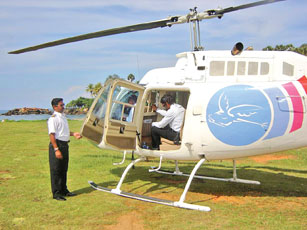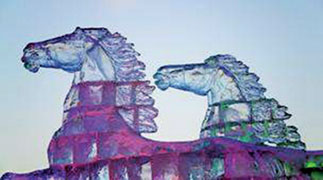TRAVEL
East coast - a hot destination for heli flights
Against a backdrop of increasing economic activity in all parts of
the country domestic airlines such as Deccan Aviation reports a
significant increase in domestic flights to the North and the East.
The company said that the average sector flying time is on the rise
with more flights being taken to the east coast.
Trincomalee, Pasikudah and Arugam Bay top the list of hot
destinations. With over 180 established helipads in the country,
helicopter charters are becoming an essential travel option to both
business and leisure travellers.
 "In this day and age, business travellers look for something extra,
cruising at 160 km per hour with a range of 480 km, helicopters allow
guests to make multiple visits and return the same day avoiding the
stress associated with travelling by road and the extra cost of
accommodation", said CEO Deccan Aviation Lanka Denham Schokman. "In this day and age, business travellers look for something extra,
cruising at 160 km per hour with a range of 480 km, helicopters allow
guests to make multiple visits and return the same day avoiding the
stress associated with travelling by road and the extra cost of
accommodation", said CEO Deccan Aviation Lanka Denham Schokman.
Deccan has been the sole internal air option for both leisure and
corporate clients over the past six years operating to all parts of the
country.
"Our guests get to land directly at their site, this is a utility
unmatched by any plane, all we need is a 15 x 15m obstruction free
space, it could be a private property a Municipal council/school ground
or even a beach front".
The typical client profile can range from an investor team visiting a
potential project site, real estate brokers hunting for property, a
production company capturing footage to develop a documentary on Sri
Lanka to leisure travellers seeking to indulge in some of the best
beaches in the world.
Typically, once they land, corporate guests tend to spend a few hours
on ground before they return back to Colombo, Deccan Aviation provides a
complete end-to-end service from ground transportation to arranging
local guides.
The company recently introduced a helicopter schedule service
connecting the international airport with major tourist destinations in
the south coast.
"We see a lot of opportunity to extend our schedule to the east coast
especially during the season, definite plans are under way to induct an
eight seat fixed wing aircraft which is scheduled to be in Sri Lanka
early 2011 in time for the season".
The new service is set to completely disrupt the pricing of air
travel, enabling passengers to fly within Sri Lanka at a cost less than
travelling by road.
Emirates sponsors authors to the GLF
Two award-winning African writers and a popular Sri Lanka born
novelist will be among the eminent authors participating in the 2011
Galle Literary Festival (GLF), thanks to Emirates, a fourth-time sponsor
of this annual event.
South African Damon Galgut, Nigerian Chimamanda Adichie and Karen
Roberts, now resident in California, have been provided with travel
sponsorship to the festival by the award-winning Dubai-based
international airline.
"Emirates is happy to support the GLF once again," said the airline's
Area Manager for Sri Lanka and Maldives Chandana de Silva. "The festival
continues to gain in stature and has become a significant event on the
country's events calendar. It has also helped to generate visibility for
Sri Lanka among an important segment of international travellers -
writers and literature enthusiasts."
Popular authors sponsored by Emirates at previous editions of the GLF
include Michelle de Kretser, Ru Freeman, Vasugi V. Ganeshananthan and
Germaine Greer.
An award-winning South African playwright and novelist who lives in
Cape Town, Damon Galgut was born in Pretoria, South Africa in 1963. He
was only 17 when his debut novel, A Sinless Season, was published.
Chimamanda Ngozi Adichie was born in Nigeria in 1977 and holds a Masters
degree in Creative Writing from Johns Hopkins and a Masters degree in
African Studies from Yale. Her first novel Purple Hibiscus won the
Commonwealth Writers' Prize and the Hurston/Wright Legacy Award. It was
also short-listed for the Orange Prize and the John Llewellyn Rhys Prize
and long-listed for the Booker Prize. Born and raised in Colombo, Karen
Roberts worked in advertising in Colombo and Dubai, and now lives in
California. Her first novel, Flower Boy, was published by Random House
in 2000. Her second book July is set in Sri Lanka before and during the
riots of July 1983. Roberts' latest novel The Lament of the Dhobi Woman
was published in 2010.
Her work addresses the various ethnic and class divisions of Sri
Lanka, often through romantic relationships between characters from
different sides of class or ethnic divides.
Chill out in China: Harbin's Ice and Snow Festival
Temperatures that can dip to - 30C, ferocious winds that howl down
from Siberia and a distinct lack of sunlight from the mid-afternoon
through the night might not sound like the ideal weather conditions for
a holiday.
In Harbin, though, the arrival of winter signals the beginning of the
peak tourist season. From late December, visitors flock to this city in
Heilongjiang Province in the north-east of China to experience one of
the finest ice and snow festivals anywhere in the world.
 Hundreds of gigantic, intricate ice and snow sculptures line both
sides of the banks of the frozen Songhua River, which cuts through
Harbin. Ever wondered what the Forbidden City or the Great Wall would
look like if they were made of ice? Or perhaps Paris' Notre Dame
Cathedral and Egypt's Sphinx? You will also see icy versions of pagodas,
skyscrapers, dragons and sea monsters. Hundreds of gigantic, intricate ice and snow sculptures line both
sides of the banks of the frozen Songhua River, which cuts through
Harbin. Ever wondered what the Forbidden City or the Great Wall would
look like if they were made of ice? Or perhaps Paris' Notre Dame
Cathedral and Egypt's Sphinx? You will also see icy versions of pagodas,
skyscrapers, dragons and sea monsters.
Carved by around 15,000 workers and designed by local engineering
students, the sculptures are normally ready by late December, although
the festival does not officially start until January 5. At night they
are lit up by multi-coloured lasers and lanterns. The effect is magical
enough to take your breath away - if there were not already a freezing
mist hanging in front of you. But the upside of Heilongjiang's
arctic-like climate, which corresponds to that of neighbouring Russia,
is that it is often close to the end of February before the sculptures
start to melt.
Launched in 1963, Harbin's festival is now ranked as one of the four
largest ice and snow carnivals in the world and attracts close on a
million visitors. Many are Chinese tourists from warmer parts of the
country, for whom snow and ice is an unseen novelty. The festival has
also contributed to Heilongjiang's growing reputation as a winter sports
playground. China's best ski slopes are at the nearby Yabuli Ski Resort,
while in Harbin itself the Songhua River provides space for ice skaters
and ice hockey games. Now, Harbin is expected to bid to host the 2022
Winter Olympics.
Harbin's history snow and ice are only one part of the city's unique
charms. Like Shanghai, Harbin has a remarkable recent history of foreign
influence. Until the end of the 19th Century, Harbin was little more
than a fishing port, but the construction of a railway line from
Vladivostok in Russia in 1896 transformed Harbin into one of China's
most cosmopolitan cities. Russian traders and Jews escaping pogroms were
the first arrivals.
Then the outbreak of the Russian Revolution resulted in Harbin
becoming a refuge for those fleeing the Bolsheviks. By the mid-1920s,
more than 100,000 Russians were calling Harbin home.
Far less welcome was the Japanese army, who operated an infamous
concentration camp in Harbin's southern suburbs in the 1930s. The camp
is now a very sobering museum. The Russian legacy lives on in the
abandoned Russian Orthodox churches dotted around town, and a former
synagogue is now an excellent museum covering Harbin's Jewish past.
Most evocative of all, though, is the Daoliqu district. Its centre is
Zhongyang Dajie, a street lined with early 20th century buildings in a
mish-mash of European architectural styles. Some are now hotels, like
1906's art nouveau-inspired Modern Hotel. Harbin is also home to the
vast Sun Island Park and a Siberian Tiger Park. Best of all, Harbin is a
surprisingly laid back and friendly place.
The pedestrianised Zhongyang Dajie and the long river front make
walking an attractive choice, which is not the case in most Chinese
cities, as well as providing endless eating options. Just do not forget
to wrap up warm. |

